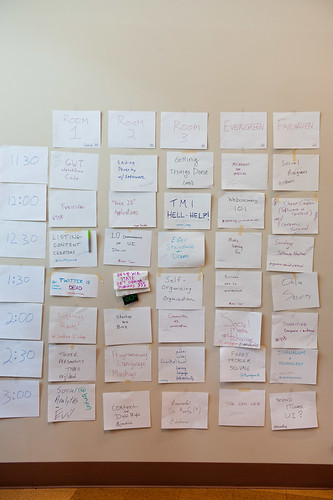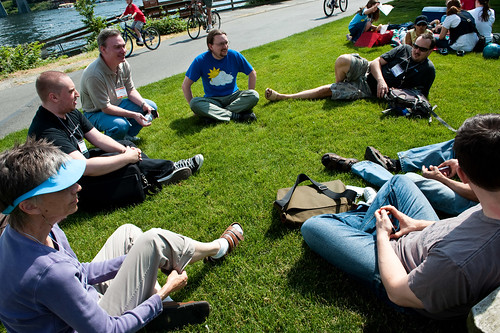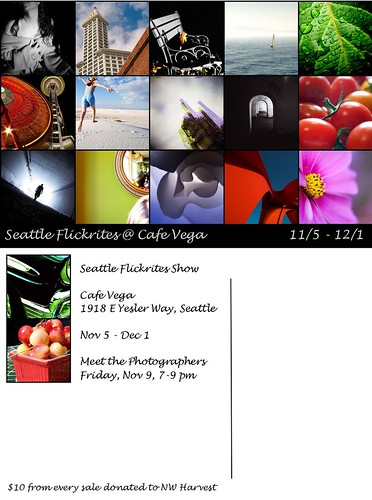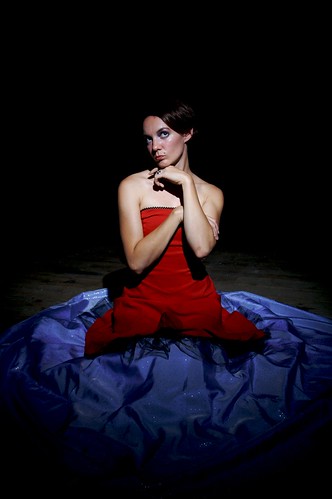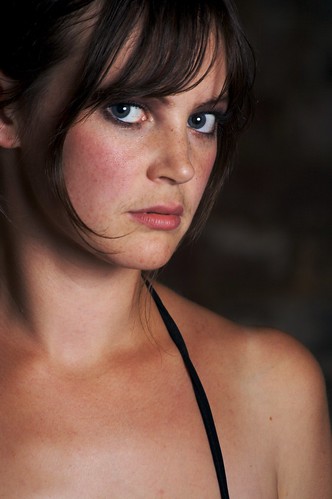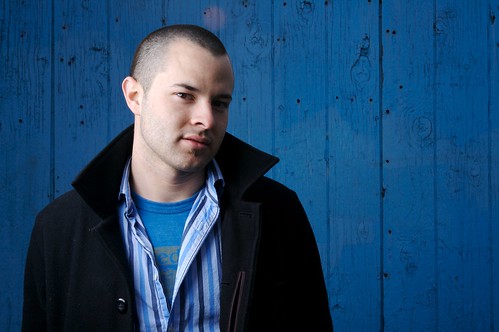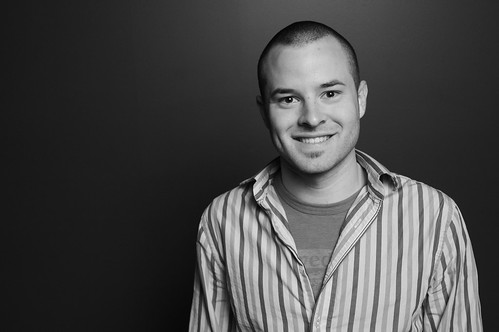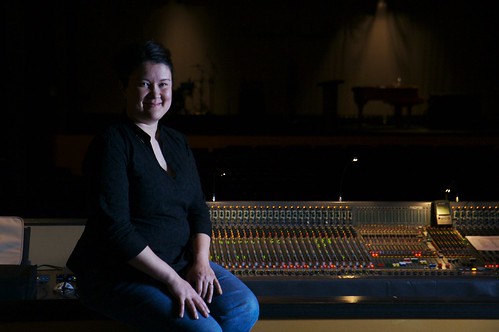I spent yesterday over in Seatac at the first of David Hobby’s two Seattle Strobist seminars. I had pretty high expectations for this, because David has set such a high standard on his blog. I also was hoping that David would go at fast pace, but I was prepared for the fact that he might need to slow down enough to keep the material accessible for those just getting started. I was definitely not disappointed on either count. The format of the day is pretty simple. Introductions and a chance for David to find out if people have particular interests, some lecture on theory, and then watching David set up a shoot of a hypothetical important person, using whatever room he’s been given.
There are so many different kinds of content at a seminar like this. There’s the straight “theory content”, which in this case was a fleshing out of the 7 Light Controls that David outlined at the beginning of Lighting 102 David’s style is really interactive, so as he walked us through each of the controls, there were digressions, questions from the participants and demonstrations. \
Another type of content is watching someone put that content into practice. I’ve always found that I learn something by watching someone else shoot. With someone like David, that experience is multiplied because you see how the theory he’s been discussing gets translated in to actual practice. Of course, you can take the theory and other content from David’s site and do that (and a *lot* of people are, as the Strobist Flickr pool will attest), but there are a lot of nuances that you just have to see in order to pick up. A number of other attendees said this to me in asides as we were watching. For the shoot of the important person, David’s goal was to do 4-5 completely different looks, using the exactly same room. You can see exemplars of the various looks in David’s Flickr stream (this is the first). If you look, you’ll see that they are completely different from each other. We saw gelling walls to different colors, making a wall of any color go to white (or black), making a highly reflective surface (projector screen) into a “blowaway” white background, turning a stack of drinking glasses into an abstract background, and more. In addition to the lighting aspects, I also found it instructive to see how David directed a subject’s posing and how he interacted with a subject to build a rapport.
The last kind of content is the hallway track content, which broke down two ways. One reason that I signed up for the seminar, was that I wanted to meet other people local to Seattle who were motivated enough about lighting to put down some money, in the hopes of finding some folks to shoot/talk with. That definitely happened, and there’ll be more on that in another post. The other part of the hallway track was the chance to hang out with David (and a bunch of other people) in the hotel bar after the official time was over. David is as personable and funny in person as he is on the site, and we had a great time with everything from full vs partial RSS feeds, how Knottyy has gone from 0-100 on landscape shooting, to the history of the Seattle underground, to way over my head stuff having to do with LAB color in Photoshop. It was totally a blast.

(ironic for the Strobist to get shot with an on camera pop-up flash – but it was late)
Here are some of my personal takeaways:
- I need to expand my imagination – That’s what is limiting the kinds of shot I want to do, or am willing to try
- I need to just experiment and not be afraid to burn frames – David’s style is very organic and exploratory. You have to be willing to try things and see if they will work. The drinking glass background was a great example of this. Ironically, I seem to need to learn this lesson over and over. Even though the “freeness” of digital frames was what got me back into photography, I realized that I have not been as willing to experiment as I probably should be
- I have more backgrounds than I think I do – Another thing that has been holding me back from shooting more at home (with my abundant supply of models) is feeling like I don’t have any good clean backgrounds to work with. Yesterday’s shoot pretty much demolished that idea.
- 1/4 CTO gels are my friend – I’ve done just about nothing with gels. Well except for the gel that I somehow melted. David is gelling just about all the time.
- Set up thoroughly so you can get people in and out and not burn up your “rapport time” – I’ve actually had some recent experience with this, but hearing David talk about various shoots that he’s done really drove this point home.
- I need to build some grids and gobos. I built a set of the cereal box snoots, and I’ve used them for a few shots, but I don’t like the rectangular shape of the light, so I’ve laid off of them. But I knew after the OneLight that I really like grids, and seeing David’s grids just pushed me over the edge.
- Cross light, cross light, cross light – I have learned to think in terms of balancing lights, but I haven’t really internalized looking for cross lighting situations.
Strobist vs OneLight
At the moment, I am probably the only person in the world who has attended both Zack Aria’s OneLight workshop and David Hobby’s Strobist Seminar, so a comparison is inevitable. Heck, David was asking me about it in the bar.
The OneLight is a completely self contained workshop. Zack does not assume that you have any prior experience with off camera lighting, which makes the OneLight perfect if workshops are a good learning style for you. You can start from nothing and get the basics all in one day. One major advantage of the OneLight is that after a full day of lecture and theory, you spend another 4-5 hours doing hands on shooting. Zack gets a model, and he and the workshop participants walk the model around and shoot using the stuff that you learned. Zack is right there to look at your images, give you feedback or help, and he swears not to go home until all your questions are answered. And he means it. Zack’s background is a music photographer, so you are also get his view of the photography world. I personally found that to be refreshing and interesting. Zack also had a different take on equipment, which I found interesting. In particular, I never would have found out about the awesome Westcott Apollo series of umbrella mount softboxes if it hadn’t been for the OneLight.
The Strobist Seminar is a slightly different animal because it also has the Strobist blog, and the enormous Strobist community around it. That means that David can leverage those things to make the seminar work well, both before (he asked some of the novices to at least read through Lighting 101), and after (you know there will be massive Flickr threads) the event. You will definitely get more out of the seminar if you have at least looked through the site. The one thing that David doesn’t do is take you shooting and help you out and give you feedback. Many of my fellow attendees expressed a desire to do that. Doing two seminars back to back makes that a tough proposition for David, and it would raise the cost because of the need to hire a model.
In the end, I spent the money for both workshops, and I’m not sorry about either one. When I took the OneLight, I had done David’s lighting bootcamp, but I still found that I learned things, and the experience of watching/shooting with someone experienced was well worth it. I would say that the Strobist workshop is stronger on the theory, and that the only real lack is the shooting part. I’d jump at the chance to participate in a David mentored DINFOS type shoot. In the end, I don’t think you can really go wrong with either one. It’s probably more a question of getting to one in your area. I was super fortunate that both of these came to Seattle this year. As photo workshops go, they are both pretty inexpensive – both of these dudes could be charging more. In fact, I mentioned this to David yesterday, and he told me that he didn’t feel it was in keeping with the spirit of the site to charge more, and he assured me that eating was not going to be a problem for him any time soon. I love a man who can live by his principles.
Update: I forgot to mention that there are a few setup photos in my Flickr stream…
